Thimble
A thimble is a small hard pitted cup worn for protection on the finger that pushes the needle in sewing. Usually, thimbles with a closed top are used by dressmakers but special thimbles with an opening at the end are used by tailors as this allows them to manipulate the cloth more easily. Finger guards differ from tailors' thimbles in that they often have a top but are open on one side. Some finger guards are little more than a finger shield attached to a ring to maintain the guard in place. The Old English word þȳmel, the ancestor of thimble, is derived from Old English þūma, the ancestor of the English word ‘thumb’.[1]
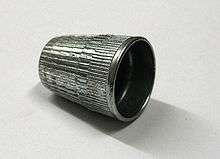

History
Pre-17th century
As the purpose of a thimble is to prevent discomfort while sewing by providing a barrier between fingertips and the blunt end of a needle, it is likely that the earliest thimbles were created closely following the invention of sewing.[2]
According to the United Kingdom Detector Finds Database,[3] thimbles dating to the 10th century have been found in England, and thimbles were in widespread use there by the 14th century.
Although there are isolated examples of thimbles made of precious metals—Elizabeth I is said to have given one of her ladies-in-waiting a thimble set with precious stones—the vast majority of metal thimbles were made of brass. Medieval thimbles were either cast brass or made from hammered sheet. Early centers of thimble production were those places known for brass-working, starting with Nuremberg in the 15th century, and moving to Holland by the 17th.
 A very early hand dimpled soldered cylinder thimble.
A very early hand dimpled soldered cylinder thimble.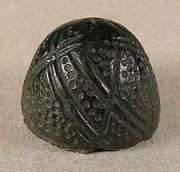 Cast 14th century thimble.
Cast 14th century thimble.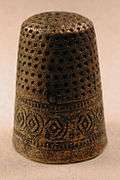 Deep drawn Nürnberg thimble. 16th century.
Deep drawn Nürnberg thimble. 16th century.
17th century and later

In 1693, a Dutch thimble manufacturer named John Lofting established a thimble manufactory in Islington, in London, England, expanding British thimble production to new heights. He later moved his mill to Buckinghamshire to take advantage of water-powered production, resulting in a capacity to produce more than two million thimbles per year. By the end of the 18th century, thimble making had moved to Birmingham, and shifted to the "deep drawing" method of manufacture, which alternated hammering of sheet metals with annealing, and produced a thinner-skinned thimble with a taller shape. At the same time, cheaper sources of silver from the Americas made silver thimbles a popular item for the first time.[3]
Thimbles are usually made from metal, leather, rubber, and wood, and even glass or china. Early thimbles were sometimes made from whale bone, horn, or ivory. Natural sources were also utilized such as Connemara marble, bog oak, or mother of pearl. Rarer works from thimble makers utilized diamonds, sapphires, or rubies.
Advanced thimblemakers enhanced thimbles with semi-precious stones to adorn the apex or along the outer rim. Cabochon adornments are sometimes made of cinnabar, agate, moonstone, or amber. Thimble artists would also utilize enameling, or the Guilloché techniques advanced by Peter Carl Fabergé.[4]
As collectibles
Originally, thimbles were used simply solely for pushing a needle through fabric or leather as it was being sewn. Since then, however, they have gained many other uses. From the 16th century onwards[5] silver thimbles were regarded as an ideal gift for ladies.

Early Meissen porcelain and elaborate, decorated gold thimbles were also given as 'keepsakes' and were usually quite unsuitable for sewing. This tradition has continued to the present day. In the early modern period, thimbles were used to measure spirits, and gunpowder, which brought rise to the phrase "just a thimbleful". Prostitutes used them in the practice of thimble-knocking where they would tap on a window to announce their presence.[6] Thimble-knocking also refers to the practice of Victorian schoolmistresses who would tap on the heads of unruly pupils with dames thimbles.[7]
Before the 18th century the small dimples on the outside of a thimble were made by hand punching, but in the middle of that century, a machine was invented to do the job. If one finds a thimble with an irregular pattern of dimples, it was likely made before the 1850s. Another consequence of the mechanization of thimble production is that the shape and the thickness of the metal changed. Early thimbles tend to be quite thick and to have a pronounced dome on the top. The metal on later ones is thinner and the top is flatter.
Collecting thimbles became popular in the UK when many companies made special thimbles to commemorate the Great Exhibition held in the Crystal Palace in Hyde Park, London. In the 19th century, many thimbles were made from silver; however, it was found that silver is too soft a metal and can be easily punctured by most needles. Charles Horner solved the problem by creating thimbles consisting of a steel core covered inside and out by silver, so that they retained their aesthetics but were now more practical and durable. He called his thimble the Dorcas, and these are now popular with collectors. There is a small display of his work in Bankfield Museum, Halifax, England.
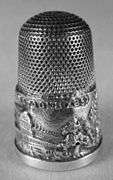 Silver thimble commemorating the Great Exhibition
Silver thimble commemorating the Great Exhibition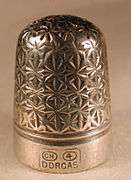 Dorcas thimble
Dorcas thimble
Early American thimbles made of whale bone or tooth featuring miniature scrimshaw designs are considered valuable collectibles. Such rare thimbles are prominently featured in a number of New England Whaling Museums.[8]
During the First World War, silver thimbles were collected from "those who had nothing to give" by the British government and melted down to buy hospital equipment.[9] In the 1930s and 1940s glass-topped thimbles were used for advertising.
Leaving a sandalwood thimble in a fabric store was a common practice for keeping moths away.[10] Thimbles have also been used as love-tokens and to commemorate important events. People who collect thimbles are known as digitabulists. One superstition about thimbles says that if you have three thimbles given to you, you will never be married.[11]
Known thimble makers
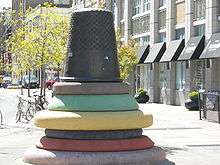
Most of these thimble makers no longer create thimbles.
- Avon Fashion Thimbles
- Wicks (Inventor USA)
- A Feaù and René Lorillon (French)
- Charles Horner (UK) (1837–1896)
- Charles Iles (UK)
- Charles May
- Anthony Stavrianoudakis (GR)
- Gabler Bros (German)
- Henry Fidkin (UK)
- Henry Griffith (UK)
- James Fenton (UK)
- James Swann (UK)
- Jean Levy (France)
- Johan Caspar Rumpe (Germany)
- Ketcham & McDougall (USA) (out of business 1988)
- Meissen (German)
- Roger Lenain (French)
- Samuel & Foskett (UK)
- Simons Bros Co (USA)[12]
- Stern Bros & Co (USA)
- Waite-Thresher (USA)
- Webster (USA)
- William Prym (Germany)
Thimblette
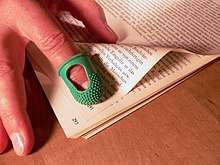
Thimblettes (also known as rubber finger, rubber thimbles and finger cones) are soft thimbles, made predominately of rubber, used primarily for leafing through or counting documents, bank notes, tickets, or forms. They also protect against paper cuts as a secondary function. Unlike thimbles, the softer thimblettes become worn over time. They are considered disposable and sold in boxes. The surface is dimpled with the dimples inverted to provide better grip. Thimblettes are sized from 00 through to 3.
A finger cot is a smooth rubber "glove finger" used to protect the finger or the item being handled.
Sewing palm
A variation on the thimble used by sailmakers and leather workers is the sewing palm, known by various others names such as seaming palm, sail palm, sailmaker's palm or roping palm.[13][14] This item consists of a pitted hard plate set into a stiff leather band that is worn around the palm of the hand, with the plate resting against the first joint of the thumb. It is used by grasping a needle between the thumb and indexing finger, with the eye end of the needle against the pitted plate, and pushing the needle with the entire arm.[15] This design permits the sewer to exert a great amount of force when pushing thick needles through very tough materials such as sail cloth, canvas or leather.[16]
Cultural references
In the Parker Brothers board game Monopoly, first created in 1904, the thimble was one of the eight traditional metal game pieces used to mark a player's position on the game board. However, this piece is being replaced in the new versions of the board game in August 2017 following public consultation.[17]
Thimbles are given as gifts in Peter Pan, who thinks thimbles are kisses.
In the 1992 movie Batman Returns, Catwoman, played by Michelle Pfeiffer, used thimbles to create the base of her claws.
The popular TV show and comic strip Popeye was originally called Thimble Theatre Starring Popeye.
The character Elizabeth in the video game BioShock Infinite uses a thimble to cover her severed little finger.
Video montages and series of clips are often called "thimble collections".
In the 2000 movie Chicken Run, Nick and Fetcher attempted to sell a couple of thimbles to Ginger as a "quality, hand crafted tea set", among a slew of other items.[18]
Auction records
On December 3, 1979, a London dealer bid the sum of $18,000 USD for a dentil shaped Meissen porcelain thimble, circa 1740, at Christie's auction in Geneva, Switzerland. The thimble, just over a half inch high, was painted in a rare lemon-yellow color about the band. It also had tiny harbor scene hand painted within gold-trimmed cartouches. The rim was scalloped with fired gold on its bottom edge. The thimble now belongs to a Meissen collector in Canada who wanted it for its lemon-yellow color.[19]
During November 1994, Sirthey's saleroom yielded a one of a kind Meissen thimble bearing an armorial coat of arms at the price of GBP 26,000.
On 13 June 1995, Sotheby's sold a Meissen thimble adorned with two pugs for GBP 10,350.
Additional pictures
_(FindID_544385).jpg) 16th-17th century English copper sewing ring
16th-17th century English copper sewing ring 17th century English silver
17th century English silver 17th century Jacobean brass
17th century Jacobean brass 17th century Jacobean silver
17th century Jacobean silver 18th century French gold
18th century French gold 18th century silver filigree with scent bottle
18th century silver filigree with scent bottle 19th century Dutch fingerguard
19th century Dutch fingerguard 19th century English Tunbridge (wood)
19th century English Tunbridge (wood) 19th century French mother of pearl – Palais Royal
19th century French mother of pearl – Palais Royal 20th century English souvenir - Abbotsford House
20th century English souvenir - Abbotsford House.jpg) 20th century Norwegian enamel (basse-taille) – David Anderson
20th century Norwegian enamel (basse-taille) – David Anderson Pre-revolution Russian silver gilt filigree
Pre-revolution Russian silver gilt filigree Pre-revolution Russian gold
Pre-revolution Russian gold 20th century Royal Worcester – William Powell painter
20th century Royal Worcester – William Powell painter 20th century Swedish gold
20th century Swedish gold 20th century French silver – F Vernon 'Sewing girls'
20th century French silver – F Vernon 'Sewing girls' 20th century Norwegian enamel (guilloché)
20th century Norwegian enamel (guilloché)
References
- "thimble - Word Histories and Mysteries - Credo Reference". Credoreference.com. Retrieved 13 January 2018.
- Hill, E. (1995). "Thimbles and Thimble Rings from the Circum-Caribbean Region, 1500-1800: Chronology and Identification". Historical Archaeology. 29 (1): 84–92. doi:10.1007/BF03374210. JSTOR 25616355.
- "Thimbles - ukdfd". www.ukdfd.co.uk. Retrieved 13 January 2018.
- Isbister, Magdalena; Isbister, William. "Fabergé Thimbles". More about Thimbles. Archived from the original on 2012-12-25. Retrieved 2012-12-11.
- Holmes E.F. (1985). A history of Thimbles. London: Cornwall Books.
- Dreesmann C. A thimble full.… Utrecht/Netherlands: Cambium, 1983. pp.75.
- "Thimbles: Not as Simple as they Seem - Fun Facts, Questions, Answers, Information". Funtrivia.com.
- The Hunt Collection, Washington Historical Society, Washington, Connecticut.
- "A history of the humble thimble - Finding Shakespeare". Finding Shakespeare.
- Holmes EF. A history of thimbles. London: Cornwall Books, 1985. pp. 128.
- "THIMBLE" A Dictionary of Superstitions. Ed. Iona Opie and Moira Tatem. Oxford University Press, 1996. Oxford Reference Online. Oxford University Press. Westminster College (PA). 28 August 2012
- "Simons Brothers Company: Jewelry Manufacturers". Simonsbrothers.com.
- Ashley, Clifford W. (1993) [1944], The Ashley Book of Knots, New York: Doubleday, pp. 20–22, ISBN 0-385-04025-3
- United States Government US Army (3 September 2013). Technical Manual TM 4-42.21 (FM 10-16) General Fabric Repair July 2013. ebook Publishing Team. pp. 7–3. ISBN 978-1-4923-2099-9.
- Hervey Garrett Smith (8 August 2012). The Arts of the Sailor: Knotting, Splicing and Ropework. Courier Corporation. ISBN 978-0-486-13268-6.
- Don Casey (1 June 1996). Canvaswork and Sail Repair. McGraw Hill Professional. ISBN 978-0-07-013391-4.
- "Thimble playing piece dropped from new Monopoly game - BBC Newsbeat". Bbc.co.uk. 16 February 2017. Retrieved 13 January 2018.
- Chicken Run (2000) - Quotes - IMDb, retrieved 2018-06-30
- Holmes EF. Thimble Notes and Queries, 1992; 14: 13
Further reading
- E. F. Holmes. A history of thimbles. London: Cornwall Books, 1985.
- J. J. von Hoelle. Thimble collector's encyclopedia. Illinois: Wallace-Homestead Book Company, 1986.
- E. Zalkin. Zalkin's Handbook of Thimbles & Sewing Implements, 1st ed. Willow Grove: Warman Publishing Co., Inc., 1985.
- M. Isbister, W. H. Isbister. More about thimbles.
External links
| Wikimedia Commons has media related to Thimbles. |
- Little Thimble, Big Journey illustrated article on thimble history
- Fabergé thimbles